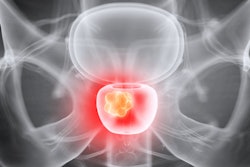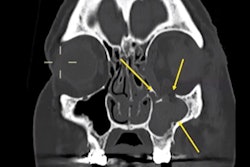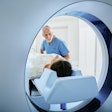
Overnight on-call shifts can cause extreme anxiety for radiologists, but there are ways to navigate them and improve the experience. Dr. Elizabeth Dick of Imperial College in London gave her top tips at a special trainees' session on 3 March at ECR 2021.
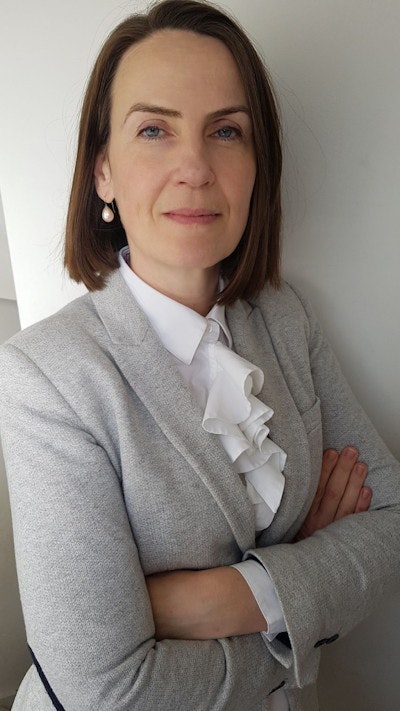 Dr. Elizabeth Dick.
Dr. Elizabeth Dick.Overall, radiologists on overnight call should keep in mind that there are resources available to support them, said Dick, who is also current president of the European Society of Emergency Radiology.
"There are a lot of people in the hospital available and willing to help," she said. "You'd be amazed how much you learn when you ask for [support]."
Dick's talk was part of a Radiology Trainees Forum session that also covered management of acute ischemic stroke and myotendinous junction anatomy and its clinical/radiological importance. In her presentation, she offered 12 recommendations for navigating a first night on call:
- Prepare by assessing your working environment. Make sure your login credentials and ID badge work, that you can access key websites, and that you have important phone numbers.
- Remember that you only have to make it to the morning. "Don't put too much pressure on yourself," Dick said. "You don't have to make subtle or very tricky diagnoses -- you just have to answer the clinical question." Try not to "puzzle over tiny details that are subtle" -- they won't make a difference overnight, according to Dick. For example, in subsegmental pulmonary arteries, it can be difficult to determine whether there is a pulmonary embolism (PE), but "even if there's a tiny PE in the subsegmental region, if you don't see something elsewhere, it's not really going to matter if you don't pick that up in the middle of the night," she said.
- When there is a pulmonary embolism, it is usually very obvious. "Don't sweat too much over the tiny potential not-quite-sure-it's-filled pulmonary arteries," she said.
- Take care of yourself. "Bring plenty of food for yourself, wear comfortable clothes. Try to make your working environment as comfortable as possible overnight.
- Be aware of the effects of sleep deprivation. "You're going to be sleep-deprived however much you prepare, and that has profound impacts on your physiology," she said. "Cut yourself slack, and be more cautious in clinical approach than you may normally be." She referenced an online interview with Dr. Michael Farquhar of Evelina London Children's Hospital regarding how to work safely on night shifts.
- Manage interruptions. "Use a paper checklist for each patient so that when you're interrupted, you can find where you were," she said.
- Use a checklist to avoid "satisfaction of search." For example, in a patient with a significant liver laceration, it's easy to forget to look for other injuries, according to Dick.
- Use the checklist to avoid skipping any structures. "It's easy to hone in on the clinical question, but if you go in a logical way you can look at all structures that are important," she said. "And don't be afraid to repeat or extend a study if needed."
- Remember to alter the windows. "Use lung windows for free air," Dick said. "Look at the porta, the mesenteric folds."
- Say yes to everything, but also make your priorities clear. Don't battle with those asking for investigations, it will sap your energy," Dick said. "If necessary, let them know that you have some sick patients ahead of their patient, so it may take a while."
- Be nice to everyone. "Civility saves lives," she said. "When [requesting physicians] people phone and are irritated or angry, if you're nice you'll be able to bring them back to being nice to you, and that's good for patients."
- Don't be afraid to ask for help. If you haven't seen a finding before, compare it to the patient's normal side or to a previous patient. Use web resources like Radiopaedia. But overall, don't be afraid to ask for help. "Triage cases into 'I can do this' and 'I need help,' " Dick said. "And ask for help early."
In response to a question from an attendee about how to handle being the sole radiologist at a small facility, Dick suggested speaking to a friend.
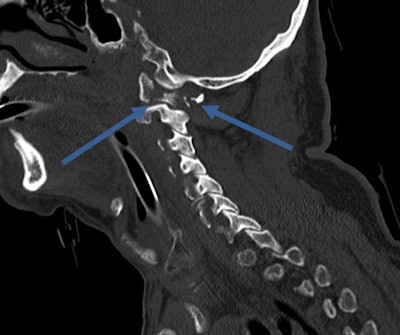 Always remember that numerous fractures can come from seemingly minor accidents. In this case, a 70-year-old fell downstairs, causing a fracture of the C1 ring. Image courtesy of Dr. Elizabeth Dick, first published in ECR Today newspaper.
Always remember that numerous fractures can come from seemingly minor accidents. In this case, a 70-year-old fell downstairs, causing a fracture of the C1 ring. Image courtesy of Dr. Elizabeth Dick, first published in ECR Today newspaper."When I was first on call, we had a buddy system, and the more experienced junior doctors would give us their phone number so we could call at any time overnight," she said. "And then, of course, a few years later, it's your turn to [do the same]."




